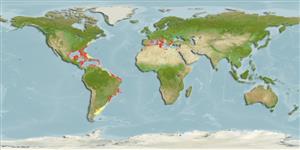Echinoidea |
Spatangoida |
Brissidae
Environment: milieu / climate zone / ระดับความลึก / distribution range
นิเวศวิทยา
; ระดับความลึก 0 - 240 m (อ้างอิง 85345). Subtropical
Atlantic and the Mediterranean Sea. Subtropical and tropical.
Length at first maturity / ขนาด / Weight / Age
วัยเจริญพันธุ์: Lm ? range ? - ? cm
Maximum depth from Ref. 83942. Infaunal (Ref. 111335). This is an epibenthic species found on rocky and soft bottom substrates in subtidal areas with depths of 0 to 240 m (Ref. 83942). Also on rubble (Ref. 111335).
Life cycle and mating behavior
วัยเจริญพันธุ์ | การสืบพันธุ์ | การวางไข่ | Eggs | ความดกของไข่ | Larvae
Members of the class Echinoidea are gonochoric. Fertilization is external. Brooding is common, eggs are held either on the peristome, around the periproct or deep into the concavities on the petaloids. Life cycle: Embryos develop into planktotrophic larvae (echinoplateus) and live for several months before they sink to the bottom using their tube feet to adhere on the ground where they metamorphose into young urchins.
Koukouras, A. and M.-S. Kitsos 2010 Echinoderms. pp.288-296 In Coll, M., et al., 2010. The biodiversity of the Mediterranean Sea: estimates, patterns, and threats. PLoS ONE 5(8):36pp. (อ้างอิง 85345)
IUCN Red List Status
(อ้างอิง 130435: Version 2025-1)
CITES status (อ้างอิง 108899)
Not Evaluated
CMS (อ้างอิง 116361)
Not Evaluated
Threat to humans
Human uses
| FishSource |
เครื่องมือ
ข้อมูลเพิ่มเติม
นิเวศวิทยาเขตร้อนFood items (preys)
องค์ประอบของอาหาร
การบริโภคอาหาร
ผู้ล่า
Population dynamicsการเจริญเติบโต
Max. ages / sizes
Length-weight rel.
Length-length rel.
Length-frequencies
Mass conversion
อุดมสมบรูณ์
Life cycleการสืบพันธุ์วัยเจริญพันธุ์ความดกของไข่การวางไข่EggsEgg developmentLarvae Human RelatedStamps, coins, misc.
แหล่งที่มาจากอินเตอร์เน็ต
Estimates based on models
Preferred temperature
(Ref.
115969): 18.6 - 27.4, mean 24.2 (based on 207 cells).
Price category
Unknown.
